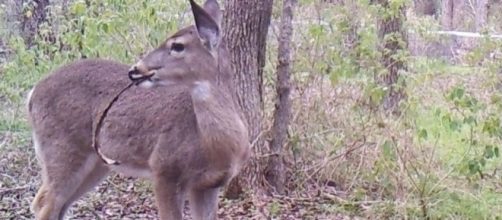In what may be the coolest or the most disturbing news you’ll read today, a white-tailed deer was photographed gnawing on the ribcage of human skeletal remains “like a cigar.” Photos taken by trail cameras at the 26-acre Forensic Anthropology Research Facility (FARF) in San Marcos, Texas captured something rather shocking – it appears Bambi isn’t exactly as docile and graceful as humans initially thought.
The researchers published a paper titled “White-tailed Deer as a Taphonomic Agent” on May 2 in the Journal of Forensic Sciences, in which they stated that this was the first known documentation of a white-tailed deer chewing on a human bone.
FARF scientists were studying the reactions of scavengers on Human Remains when they left the body in the Freeman Ranch body farm.
What’s a body farm?
A body farm is a research facility where decomposition can be studied in a variety of settings. It also provides a unique opportunity for CSI teams to replicate murder scenes in the most realistic setting possible to help law enforcement figure out what happened.
Decayed human remains are the main study of FARF. In order to study the behavior of scavengers around decomposed human bodies, the team had dropped a corpse in the facility. It commonly attracts raccoons, turkey vultures, and foxes, but by the following year, the concealed camera captured a white-tailed deer, a herbivore, seemingly emulating the behavior of scavenging animals, gnawing on a human rib bone "like a cigar," which is how the research paper described it.
They simply cannot dismiss the incident as accidental, as a similar animal did the exact same thing a week later. It's difficult to identify if it was the same deer, but the behavior was highly unusual, even to a team of scientists.
What makes this observation special?
According to Lauren A. Meckel, one of the research paper’s authors, deer may pursue flesh because its current diet lacks minerals like calcium, salt and phosphorous, especially in the winter months when plant life is limited.
While the never-before-seen deer behavior is a remarkable discovery, Forensic Scientists are also calling the study valuable for cases in which a body has long been decomposing. It’s a rarity for deer to nibble on human bones, but being able to identify the signs of ungulate gnawing may help crime scene investigators trace where a human corpse came from and how long it’s been dead. According to forensic experts, this will help uncover unsolved crime cases, especially when a scene is mysteriously mangled.


